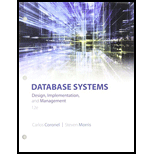
Concept explainers
Aggregate Functions:
SQL has some built-in functions and they are called as aggregate functions. SQL contains five built-in functions. They are:
- SUM – This function is used to add values from the particular column.
- Syntax: SELECT SUM(column_Name) FROM table_Name;
- COUNT – This is used to count the number of rows for the particular column.
- Syntax: SELECT COUNT(column_Name) FROM table_Name;
- MAX – This function is used to get the maximum value from the column.
- Syntax: SELECT MAX(column_Name) FROM table_Name;
- MIN – This function is used to get the minimum value from the column.
- Syntax: SELECT MIN(column_Name) FROM table_Name;
- AVG – This function is used to get the average of all the values from the column.
- Syntax: SELECT AVG(column_Name) FROM table_Name;
Grouping Rows:
SQL contains “GROUP BY” clause in order to group rows by common data. Though it is very powerful feature, it is hard to understand.
Syntax:
SELECT column_Name1 FROM table_Name GROUP BY column_Name2;
Example: Consider a table “student” contains two columns “student_Name” and “Department”. “GROUP BY” clause is used when there is a need to get the number of students from each department. The query for this scenario is given as follows.
SELECT department, COUNT (department) FROM student GROUP BY department;
When the above query is executed, number of students from each department will be displayed.
Trending nowThis is a popular solution!

Chapter 7 Solutions
Database Systems: Design, Implementation, Management, Loose-leaf Version
- Solve this "Do not use AI tools. Solve the problem by hand on paper only and upload a photo of your handwritten solution."arrow_forward"Do not use AI tools. Solve the problem by hand on paper only and upload a photo of your handwritten solution."arrow_forwardSolve this "Do not use AI tools. Solve the problem by hand on paper only and upload a photo of your handwritten solution."arrow_forward
- Solve this "Do not use AI tools. Solve the problem by hand on paper only and upload a photo of your handwritten solution."arrow_forwardSpecifications: Part-2Part-2: DescriptionIn this part of the lab, we will illuminate two 7-segment displays. You will need to understand 2's Complement todetermine when the input 4-bit binary number corresponds to a negative or positive number. To understand how anLED display works in Digital, please refer to the playWithLED_Display.dig file provided. You should play withdifferent input combinations to see how it influences the LED Display value. In the screenshot below, note how I wasable to generate the display of “3” on the Hex display by lighting up only certain input wires to the unit. Here is a picture of how the different segments light up to produce the different displays: Note in the picture above that we showed displays only from 0-8 since in 4-bit 2s complement representation, 8 is thelargest modulus value you can represent (the range of integers would be -8 to +7).Your circuit in Part-2 must accept a 4-bit 2's complement input {in3, in2, in1, in0} where in3 is the most…arrow_forwardSolve this "Do not use AI tools. Solve the problem by hand on paper only and upload a photo of your handwritten solution."arrow_forward
- Solve this "Do not use AI tools. Solve the problem by hand on paper only and upload a photo of your handwritten solution."arrow_forwardSolve this "Do not use AI tools. Solve the problem by hand on paper only and upload a photo of your handwritten solution."arrow_forwardSolve this "Do not use AI tools. Solve the problem by hand on paper only and upload a photo of your handwritten solution."arrow_forward
- Solve this "Do not use AI tools. Solve the problem by hand on paper only and upload a photo of your handwritten solution."arrow_forwardSolve this "Do not use AI tools. Solve the problem by hand on paper only and upload a photo of your handwritten solution."arrow_forwardSolve this "Do not use AI tools. Solve the problem by hand on paper only and upload a photo of your handwritten solution."arrow_forward
 Database Systems: Design, Implementation, & Manag...Computer ScienceISBN:9781305627482Author:Carlos Coronel, Steven MorrisPublisher:Cengage Learning
Database Systems: Design, Implementation, & Manag...Computer ScienceISBN:9781305627482Author:Carlos Coronel, Steven MorrisPublisher:Cengage Learning A Guide to SQLComputer ScienceISBN:9781111527273Author:Philip J. PrattPublisher:Course Technology Ptr
A Guide to SQLComputer ScienceISBN:9781111527273Author:Philip J. PrattPublisher:Course Technology Ptr

